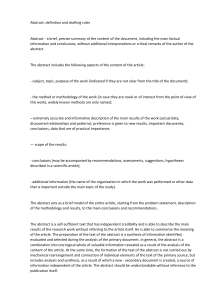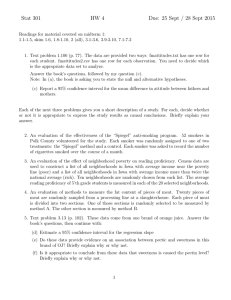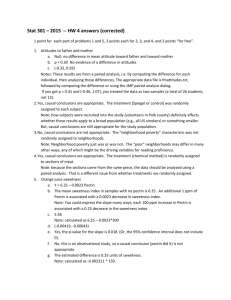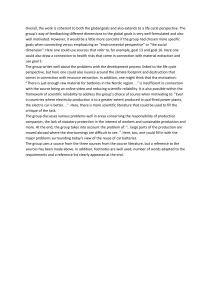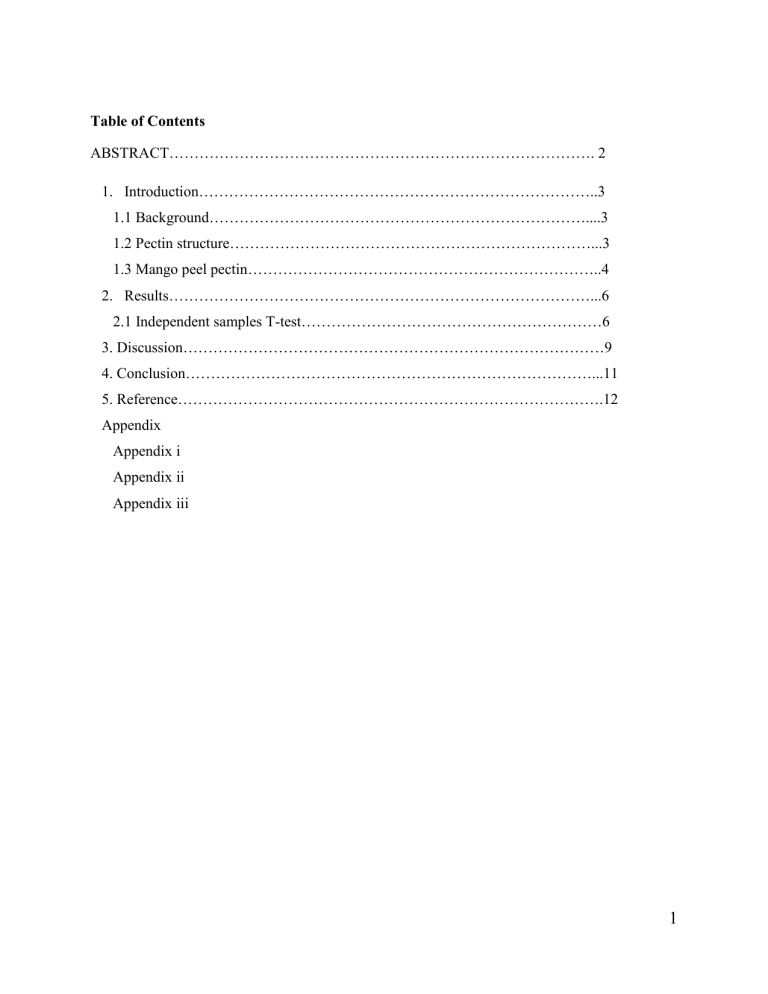
Table of Contents ABSTRACT…………………………………………………………………………. 2 1. Introduction……………………………………………………………………..3 1.1 Background…………………………………………………………………....3 1.2 Pectin structure………………………………………………………………...3 1.3 Mango peel pectin……………………………………………………………..4 2. Results…………………………………………………………………………...6 2.1 Independent samples T-test……………………………………………………6 3. Discussion…………………………………………………………………………9 4. Conclusion………………………………………………………………………...11 5. Reference………………………………………………………………………….12 Appendix Appendix i Appendix ii Appendix iii 1 Abstract A structural hetero polysaccharide known as pectin is frequently derived from peels of some fruits like orange, banana or mango. Due to its versatility, pectin is a material used in cosmetic, food, and medicinal goods because of its qualities that act as a thickener. Mango peels could be used as a source of pectin because this residue is not in use at the moment and is frequently discarded. Approximately 20% of pectin can be found in mango peels. This study examines different extraction techniques used to extract pectin from three mango cultivars (tommy atkins, glenn and palmer) with the aim of identifying the best and most effective extraction technique. The ten ripened mangos of each of the cultivars were manually peeled, carefully washed and oven-dried at 45°C for a period of two days. Afterwards, the dried peels were ground and filtered through a 100-mesh screen in order quality mango peel powder (MPP). The conventional hotacid extraction technique was used on the palmer, tommy atkins and glenn which gave a pectin yield of 15.58 g/100g DM, 21.26 g/100g DM and 11.28 g/100g DM, respectively. Furthermore, tommy atkins was subjected to two more extraction techniques in order to get the highest amount of pectin that can be extracted. Enzyme-assisted extraction and ultrasound-assisted extraction gave a pectin yield of 25.50g/100g DM and 30.89g/100g DM, respectively. The relatively high pectin yield by ultrasound-assisted extraction was due to the stronger and enhanced solvent entrance into the cells and intensification of the mass transfer caused by the collapse of cavitation bubbles near cell walls which is induced by ultrasound waves. Hence, the application of ultrasound-assisted technique has proven to be an efficient approach in recovering high pectin yield from mango peels which is an excellent quality for the food sector. 2 1 Introduction 1.1 Background Mangos are members of the family Anacardiaceae's genus Mangifera. There are numerous kinds of edible fruit-bearing plants in the genus Mangifera. The majority of mangoproducing plants are members of the Mangifera indica genus (Shah et al, 2010). Mangoes belong to the drupe family and is most times regarded to as tropical stone fruits. There is a seed in this pit. When the fruit shoulder broadens (or fills out) and part of the green fruit on the tree starts to turn yellow, the crop is said to be mature (e.g. Pride, Irwin and Tommy Atkins, etc.) (Litz, 1997). Maria et al (2019) opine that mangoes constitute phytochemicals, vitamins, and minerals, and macronutrients (carbohydrates, proteins, amino acids, lipids, and organic acids). They also stated that phenolic, polyphenol, pigments, and volatile constituents can all be found in mangoes; pectins and cellulose are also two structural carbohydrates found in mango fruit. 1.2 Pectin Structure Pectin is a significant polysaccharide that is used in a variety of industries, including food, pharmaceuticals, and others. It forms gel when exposed to Ca2+ ions or a solute with a low pH, (Prakash and Priyah, 2016). Pectin is described as a glazing agent, an emulsifier, stabilizer, gelling agent and/or thickening in commercial uses, pectin is a naturally renewable, biodegradable, biocompatible, and occurring polysaccharide (Williams et al., 2009). As a fruit's primary constituent, pectin is what causes a gel to develop when heated and combined with sugar. Pectin is typically described as water-soluble pectinic acids with varied methyl ester concentrations that, under the right circumstances, can form gels alongside sugar and acid. Pectin is a frequent culinary component because of its excellent gelling ability. The neutral sugar rhamnogalacturonan, which is also present in pectin molecules, is what splits and kinks the galacturonic acid chain (Thakur et al., 1997) While the backbone of RG-I is made up of alternating GalA and rhamnose residues, the backbones of HG, RG-II, and XGA are composed of -1, 4-linked galacturonic acid (GalA) residues that can be acetylated at O2 or O3 or methyl-esterified at the C6 carboxyl group. 3 RG-II has intricate side chains, RG-I has structurally diversified side chains mostly comprised of arabinose and galactose, and XGA is just HG with additional -1,3-xylosyl side groups. There are at least 12 different types of sugars, (Mohnen, 2008). The figure below structure and constituents of pectin 1.3 Mango Peel Pectin The mango fruit has three distinct parts: the pulp (mesocarp), the skin (epicarp), and the seed kernel (endocarp). Mango pulp is a rich source of phytochemicals such as aromatic compounds, vitamins, polyphenols, reducing sugars, anthocyanins, amino acids and pectin, as well as functionally active substances (Lebaka et al., 2021). The flesh (pulp) of the fruit is consumed the most during processing, whereas the peel and seeds—which together make up 35–60% of the weight of the fruit—are typically wasted as biomass, (Larrauri et al., 1996). The amount varies between mango kinds, but the leftovers of mango processing include peel (5–17%) and seed (7–17%). The figure 2 below shows the biomass and composition of the mango fruit. 4 About one-third of the dry content of higher plants' cell walls is made of pectin, a complex mixture of polysaccharides, (Pranati and Rishabha, 2011). These chemicals are also present in much lesser quantities in the cell walls of grasses. According to Kertesz (1951), the middle lamella of the cell wall has the largest amounts of pectin, which gradually decrease as one moves through the primary wall and into the plasma membrane. Although pectin is found in abundance in the majority of plant tissues, there are just a few sources that can be utilized in the production of pectin for commercial application. This is due to the fact that pectin's capacity to gel depends on its molecular size and esterification level (DE).Mango peel is an effective substitute for pectin extraction, according to Banerjee and colleagues in 2017. The peels were also recognized as possible sources of high and low methoxy pectin, (Banerjee et al, 2017). The successful extraction of pectin from mango peels is made possible through the application of certain extraction techniques. These extraction techniques are split into parts. The first part is the conventional method which is the Conventional Hot-acid Extraction (CHE). The other part is the novel techniques which are: Microwave-Assisted Extraction (MAE), Enzyme-Assisted Extraction (EAE), UltrasoundAssisted Extraction (UAE). In Conventional Hot-acid Extraction (CHE), pectin is always extracted in acidified water with 0.05–2 M sulfuric acid, phosphoric acid, nitric acid, hydrochloric or acetic acid, between 80 and 100 °C for one hour while stirring constantly, (Georgiev, 2013). Solvent 5 characteristics, temperature, solid-to-solvent ratio, pH, dry solids, particle diffusion rate and size are only a few of the variables that affect conventional extraction, (Mari´c et al, 2018) In Microwave-Assisted Extraction, plants molecules are exposed to microwaves, that is, it involves dielectric heating. The microwave’s irradiation speeds up cell rupture by causing an abrupt rise in internal pressure and temperature within the plant sample's cells. This encourages the destruction of the sample's surface and, in turn, causes pectin to exude from the plant cells into the surrounding solvents, increasing the risk of infection, (Maran et al, 2013). In Enzyme-Assisted Extraction (EAE), the plant cell wall matrix is hydrolyzed by the enzymes to enhance the extraction process. Enzymatic extraction of pectin uses cell walldegrading enzymes with minimal pectinolytic activity to hydrolyze non-pectin plant cell wall components, (Fissore, 2009). The EAE is influenced by reaction duration, enzyme type and concentration, pH value, temperature and plant material particle size, (Poojary et al, 2017) Ultrasound-Assisted Extraction is specifically designed for the extraction of pectin. Ultrasound-induced cavitation bubble collapses near cell walls which results in cell rupture. This, however, strengthens and improves solvent entry into the cells and intensifies the mass transfer, (Barba et al, 2015) Subcritical Water-Assisted Extraction (SWE) is a liquid at high pressure that can reach temperatures over its typical boiling point without changing phases. The SWE is promoted as a green method for valuing mango peel as a pectin product. 2. Results The dataset 1 included pectin percentage from three different mango cultivars (palmer, Tommy Atkins and Glenn) which was extracted using conventional extraction technique. The mango cultivar (Tommy Atkins) was then used for further extraction of pectin using novel extraction method (dataset 2). 50 samples of mango cultivars were analyzed in total, percentage of pectin yielded was calculated from crude pectin powder weighed. 6 2.2 Independent samples T-test The table below shows pectin yield from three different mango cultivars, using Hot-acid extraction technique. Furthermore, the table represents the average and standard deviation of the dataset 1 in Appendix 1, this average was gotten by the sum of dataset numbers and divided by the total number of value in the set. Mango cultivar Average (g/100g DM) Standard deviation (SD) Palmer 15.58 2.15 Tommy Atkins 21.26 0.59 Glenn 11.28 0.97 Table 1: Pectin yield (g/100g DM) from three mango cultivar using Hot-acid extraction technique. The extraction from mango cultivar (Tommy Atkins) using Hot-acid extraction presented the highest pectin yield (21.26 g/100g DM). This confirmed that, pectin yield from mango cultivar (Tommy Atkins) using Hot-acid extraction method, had significantly higher pectin yield comparing to mango cultivar Palmer and Glenn pectin yield. Figure 1 represents a comparison of pectin yield using Hot-acid extraction technique from three different mango cultivar and shows a significant increase in pectin yield from mango cultivar (Tommy Atkins). 7 25 pectin yield (g/100g DM) of different mango cultivar using Hot-acid extraction technique Pectin yield (g/100g DM) a 20 b 15 c 10 5 0 palmer tommy atkins mango cultivars glenn Figure 1: Comparison of pectin yield from different mango cultivar using Hot-acid extraction method. Independent samples T-test p<0.05 The table below shows pectin yield from mango cultivar (Tommy Atkins), using three different extraction methods. This table represents the average and standard deviation (SD) of the dataset 2 attached in Appendix 1, this average was gotten by the sum of dataset numbers and divided by the total number of value in the set Extraction Techniques Average (g/100g DM) Standard Deviation (SD) Hot-acid Extraction 21.26 0.59 Enzymatic Extraction 25.50 0.81 Ultrasound Extraction 30.89 0.35 Table 2: Pectin yield (g/100g DM) from mango cultivar (Tommy Atkins), using different extraction techniques. The extraction from mango cultivar (Tommy Atkins) using ultrasound extraction technique presented the highest pectin yield (30.89 g/100g DM). The figure below represents a comparison of pectin yield using different extraction technique from mango cultivar (Tommy Atkins) and shows a significant increase in pectin yield using ultrasound extraction technique. 8 This confirmed that, pectin yield from mango cultivar (Tommy Atkins) using ultrasound extraction method had significantly higher pectin yield comparing to Hot-acid and Enzymatic extraction techniques. pectin yield (g/100g DM) from mango cultivar(Tommy cultivar) using different extraction techniques 35 a 30 Pectin yield (g/100g DM) b 25 c 20 15 10 5 0 Hot-acid extraction EAE UAE Extraction techniques Figure 2: Comparison of pectin yield from mango cultivar (Tommy Atkins) using three different extraction methods. Independent samples T-test p<0.05 3. Discussion On the cultivars of the glenn, Tommy Atkins, and palmer mangoes, hot-acid extraction was applied. Pectin yields from this extraction method were 15.58 g/100 g DM, 21.26 g/100 g DM, and 11.28 g/100 g DM, respectively. The three different mango cultivars' peels were treated to temperature and time changes, which weaken plant cell walls and facilitate solvent diffusion and pectin extraction (Sayah et al., 2016). High temperatures during this extraction technique also result in a higher pectin output. Therefore, when compared to the cultivars of palmer and glenn mango, the usual extraction method (Hot-acid) utilized on Tommy Atkins yielded a larger pectin yield. During the use of Hot-acid extraction technique, the pectin yield from the mango peel of tommy atkins (mango cultivar) was 21.26 g/100g DM. However, when enzymatic extraction technique 9 was applied, the pectin yielded from tommy atkins (mango cultivar) became higher (25.50 g/100g DM). This is because cell permeability increases due to disintegration of the cell wall which is caused by hydrolyzing the matrix of the plant cell wall by enzymes used for the improvement of pectin extraction process, (Poojary et al., 2107). According to the result, pectin yield from the mango peel (tommy atkins) using ultrasound extraction technique yielded significantly the highest amount of pectin (30.89 g/100g DM). This extraction technique has proven to be very effective when extracting pectin from mango peel. In contrast to other extraction methods, ultrasound extraction produces a high yield of pectin due to stronger and improved solvent entry into the cells and intensified mass transfer brought on by the cavitation bubbles' collapse near the cell walls, which is brought on by ultrasound and results in cell disruption. (Zhu et al., 2017). The two main phases of the hot-acid extraction method are the hydrolysis of proto-pectin into pectin using acids and the subsequent ethanol precipitation (Djilas S et al., 2009). While the Enzyme Assisted Extraction (EAE) technique hydrolyzes non-pectin plant cell wall components, it also degrades plant cell walls to extract pectin utilizing pectinesterase and other enzymes with low pectinolytic activity (Puri M et al., 2012]). Ultrasound aided extraction (UAE), in contrast to the traditional method (hot-acid extraction), employs sound waves traveling through a liquid medium and causing compression and expansion. As a result, cavitation—the formation, expansion, and burst of bubbles occurs. As a result, unstable microscopic bubbles with high temperatures and pressure might occur, which alter the plant matrix and improve the extractor solvent's ability to penetrate it, (Wang et al., 2015) . As effective as the ultrasound extraction method was for extracting pectin in this experimentation, it has the drawback of not being able to significantly minimize the need for solvent. Additionally, it improves the yield and kinetics during the recovery of pectin and reduces the time required for extraction, the amount of energy used, and the amount of solvent used (Adetunji et al., 2017). Benefits of the enzyme extraction method include the utilization of high temperatures and absence of acidic pH levels during the extraction. it also doesn't have a corrosive effect on the machinery used in the process, doesn't require any special pre-treatment processes, speeds up and cuts down on the amount of time needed for extraction, improves pectin quality due to the mild conditions of enzymatic extraction (Ptichkina et al., 2008). The method has a disadvantage in that the enzyme required for it is expensive, and the way each 10 enzyme reacts differently to environmental changes makes it challenging to scale up the enzymatic extraction process. (Puri et al., 2012). According to numerous studies, pectin can deteriorate quickly during hot-acid extraction due to its high sensitivity and vulnerability to acid [Mollea C et al., 2008]. Environmental issues and the loss of an unknown quantity of volatile chemicals, according to Yang et al. (2018), are other downsides of the traditional extraction method (hot-acid extraction). However, due to increased affinity for the cation Ca2+, which stabilizes the pectin molecule, conventional extraction has the ability to precipitate pectin. (Chan et al, 2013). 4. Conclusion Around one-quarter of the mango fruit's total weigh is made up of peels. From this biomass, mango peel pectin may be extracted. From the experiment conducted on three mango cultivars (tommy atkins, glenn and palmer), the extraction of pectin varies when subjected to either the conventional or novel extraction techniques. This study has dealt with a variety of mango cultivar and has discovered that pectin can be obtained readily from all the cultivars, but excellent quality and yield is dependent on a few key sources. Hence, many extraction techniques were used and have reported various yield percentages, but the Ultrasound-assisted extraction technique is still the most trustworthy. An efficient extraction method has been demonstrated to be the use of ultrasound. As a result, this study adds to the body of evidence that the ultrasound technique always requires a short amount of time compared to other methods to successfully extract pectin. The pectin extraction yield was positively impacted by the mangoes' state of maturity, creating the possibility of using mangoes as a source of pectin that would never be commercially viable and reducing waste at this stage of production. The advantage of using ultrasound extraction technology is that it has a minimal negative influence on the environment and can be done more quickly. As a result, using this technique to remove pectin from mango peels or other waste products from the agricultural business could be successful. 11



